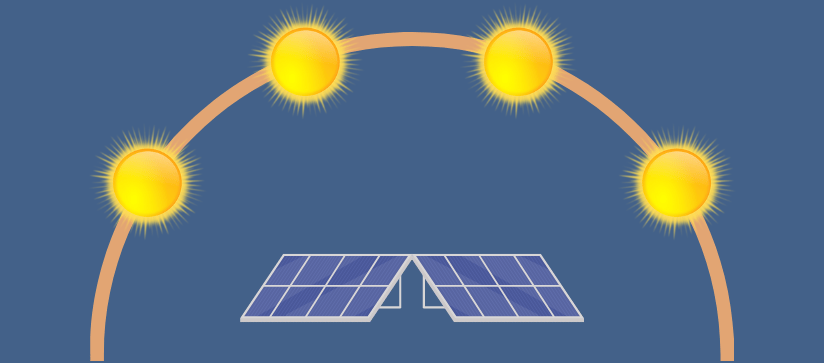
Calculate Your Optimal Solar Panel Tilt Angle
- Dismantling Solar Panel Angle Myths: What to Avoid
- Myth#1: Identical Latitudes Equate to Identical Ideal Panel Tilt Angles
- Myth#2: Latitude is All You Need for Ideal Panel Angle Calculation
- The Reality Check: Simplicity Doesn't Always Mean Accuracy
- Maximizing Your Solar PV Output: Finding Your Ideal Solar Panel Tilt Angle
- Step 1 - Deriving Daily Solar Elevation Angles at Latitude
- Step 2 - Daily Optimal Panel Tilt Angles Calculation
- Step 3 - Weighted Contribution Towards Yearly Photovoltaic Potential
- Step 4: Determining the Ideal Fixed Solar Panel Tilt Angle
- In Conclusion
- A Hassle-Free Alternative: Let Us Do the Work For You!

Dismantling Solar Panel Angle Myths: What to Avoid
Understanding the calculations of solar panel tilt angles is fundamental, but it's equally crucial to sidestep common misconceptions and misleading methods that can lead to less-than-optimal results.
Myth#1: Identical Latitudes Equate to Identical Ideal Panel Tilt Angles
A widespread fallacy is the assumption that every location at the same latitude shares an identical ideal annual fixed panel tilt angle. This presumption overlooks critical factors such as diverse meteorological conditions and varying climate characteristics across regions on the same latitude. In reality, solar output is unique for each specific set of latitude and longitude coordinates.
Despite the fact that two places on the same latitude might exhibit comparable optimal tilt angles due to their geographical position in relation to the path of the sun, variations in local conditions mean these angles won't always be identical. Consequently, it becomes evident that depending entirely on latitude is insufficient for accurately determining solar panels' ideal tilt angles. Latitude is a key factor in our calculations, but it isn't the only piece of information required for accuracy. This brings us smoothly to our next point: Myth #2...
Myth#2: Latitude is All You Need for Ideal Panel Angle Calculation
Sadly, numerous sources still contend that the sole requirement for computing the optimal solar panel tilt angle is your latitude. This simplified approach may have been sufficient in the past, when empirical solar irradiance and meteorological data specific to each location were limited. Nevertheless, with NASA's comprehensive global dataset from their Prediction of Worldwide Energy Resources (POWER) project now readily accessible at no cost, oversimplifying calculations by only considering latitude should be discontinued.
With such a trove of comprehensive information readily accessible, there's no excuse not to apply these insights and sophisticated models to better understand location-specific optimal panel tilt angles. The use of latitude alone as a determining factor falls woefully short in comparison.
The Reality Check: Simplicity Doesn't Always Mean Accuracy
Achieving optimal energy production demands more than simple calculations; it requires accounting for variations with comprehensive computations involving geographical coordinates along with extensive historical solar & meteorological data — factors that considerably influence ideal panel positioning over an entire year. By considering these factors, you can ensure your solar panels' efficient positioning captures maximum sunlight all year round.
Maximizing Your Solar PV Output: Finding Your Ideal Solar Panel Tilt Angle
The ideal angle to tilt your solar panels plays a vital role in maximizing their efficiency and output. This article aims to guide you through the process of calculating this ideal tilt angle, which varies based on geographic location and time of the year.
This guide primarily focuses on determining the optimal solar panel tilt angle for fixed panel installations. However, if you only need varying ideal solar panel tilt angles per day of the year, you can stop following after Step 2.
Step 1 - Deriving Daily Solar Elevation Angles at Latitude
The first step is to calculate the elevation angle (α) of the sun above the horizon at noon for each day of an entire year at a given latitude (φ). This can be calculated using this equation:
Here 'δ☉' refers to Declination, an astronomical term that describes a celestial body's position with respect to Earth's equator. In this context, it specifically refers to Sun's declination.
Note: The Earth's orbit around the Sun is not a perfect circle, but an ellipse with an eccentricity of 0.0167. At profileSOLAR, we take into account this elliptical position of Earth for each day of the year when calculating δ☉ (the Declination of the Sun). This added layer of precision in our calculations helps avoid potential errors—up to 1 degree—in determining δ☉. By incorporating this factor, we ensure more accurate and reliable results in our calculation of optimal solar panel tilt angles.
More information about declination can be found on this Wikipedia page.

Image Credit: Deditos: "The path of the Sun over the celestial sphere through the course of the day for an observer at 56°N latitude. The Sun's path changes with its declination during the year. The intersections of the curves with the horizontal axis show azimuths in degrees from North where the Sun rises and sets."
Step 2 - Daily Optimal Panel Tilt Angles Calculation
Once daily elevation angles are computed, your next move is deriving optimal panel tilt angles (β) for each day using this formula:
Step 3 - Weighted Contribution Towards Yearly Photovoltaic Potential
After calculating daily optimal panel tilt angles over an entire year, extensive historical solar irradiance and meteorological data records are required. NASA's Prediction of Worldwide Energy Resources provides such comprehensive datasets.
This stage involves weighting each daily optimal panel tilt based on its contribution towards total yearly Photovoltaic (PV) potential by employing this equation:
- Here,
- 'Wβ' stands for Weighted Angle,
- 'D' is the total solar energy received in one particular day (Day Sum)
- 'Y' represents cumulative solar energy received during the entire year (Year sum).
Step 4: Determining the Ideal Fixed Solar Panel Tilt Angle
Finally, to find out the ideal panel tilt angle for a specific location, add up all daily 'Wβ' values. This sum gives an annual average tilt angle that maximizes solar energy capture at your geographical location.
In Conclusion
While the process to calculate optimal tilt angles for solar panels might seem complex initially, it's important to note that most of the equations involved are straightforward and easily understood by most people. The one exception is calculating δ☉, the declination of the sun per day, which may require some additional understanding.
However, even with this complexity, getting to grips with these calculations can lead to significant improvements in solar panel efficiency. It ensures your panels are ideally positioned to capture maximum sunlight throughout the year. Therefore, taking time to understand and apply these calculations can be an investment that pays off through enhanced energy output from your solar panels.
A Hassle-Free Alternative: Let Us Do the Work For You!
For those who prefer a more effortless approach or simply don't have the time, we offer a convenient solution - we'll do the calculations for you! We're more than happy to add your city or location to our growing list of places for which we've already determined and published optimal solar panel tilt angles.
Simply reach out to us, and we'll run these calculations specifically for your city at no cost. With this service, you can rest assured that you're getting accurate results without any of the legwork.

Share this with your friends!






